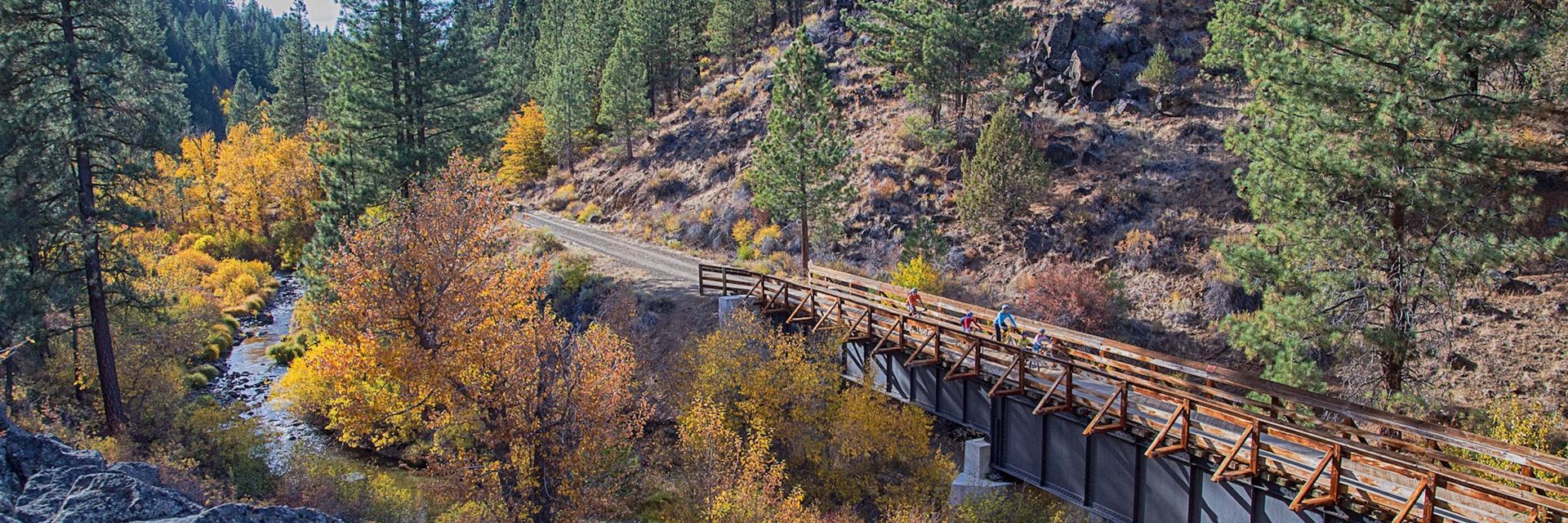How can we improve rail transit in America while also having car-free trails for bikes and pedestrians?
◊
Brown steel cantilevers stretch across the Hudson River, the skeleton of a giant in the midday sun. The wind carries across the valley, catching the early leaves of spring. A guide leads members of the Mid-Hudson Bicycle Club across grated metal walkways, swaying tree tops far below. As the clacking of bicycle shoes stops, the guide explains what’s to become of the bridge they’re standing on. It’s the spring of 2007, and the old Poughkeepsie Railroad Bridge, which has been unused since a track-warping fire in the 1970s, is set for a transformation.
The project to convert the railroad bridge into a car-free walkway was completed two years later. It marked the connection of an 18-mile rail trail stretching across Dutchess and Ulster counties, a reclamation of unused railroad that became car-free infrastructure. For this Hudson Valley region, it was the proverbial golden spike where east met west. Over 600,000 people visit the Walkway over the Hudson each year, with more branching out into the rail trail to walk, run, and ride.
The gray ribbon of pavement, winding through wooded foothills and farms, follows the route of a cargo railroad that came before it. Now, 15 years since completion, it has woven itself into the community, a source of pride for locals. But the pride is not without a cost. The completion of this pathway, and others like it nationwide, represent a largely unacknowledged challenge to bringing passenger trains back to America.
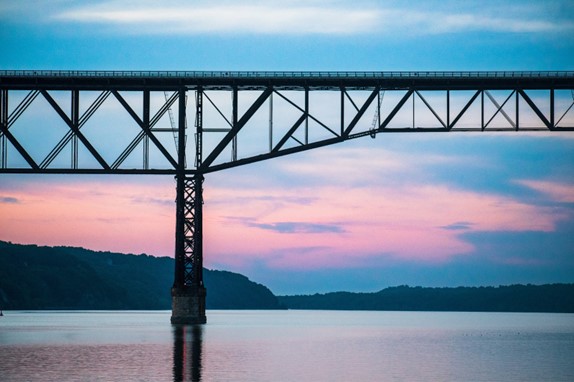
The Walkway over the Hudson, Poughkeepsie, New York (Credit: Travis Norman)
Rail Trails Are an Easy Win for Green Projects
The looming presence of American car culture influences decisions made for other means of transportation. Over 70 percent of Americans use a car to commute to work, and, with much of the population depending on automobiles, other modes of transit are left to divide up a much smaller slice of public funds and attention. Rail trails are popular, but is there a way we can have them without compromising the future for train travel?
Rail trails are the conversion of abandoned railroads into paved surfaces for walking and cycling. They were popularized beginning in 1983 as part of the National Trail Systems Act, a measure designed to preserve railroad corridors for future use. The NTSA coined the term “railbanking,” a legal mechanism whereby railroad owners can cede the land for use by trail groups, with the caveat that they may reclaim it for rail use at a later date.
Without this legal framework, ownership of the abandoned land could be divided up by the adjacent private landowners, creating a patchwork of ownership rights along the right of way. For trail groups, that would mean a much more complicated process for negotiating the development of a trail, potentially unraveling the project altogether. As with any public infrastructure project, litigation over land rights is common.
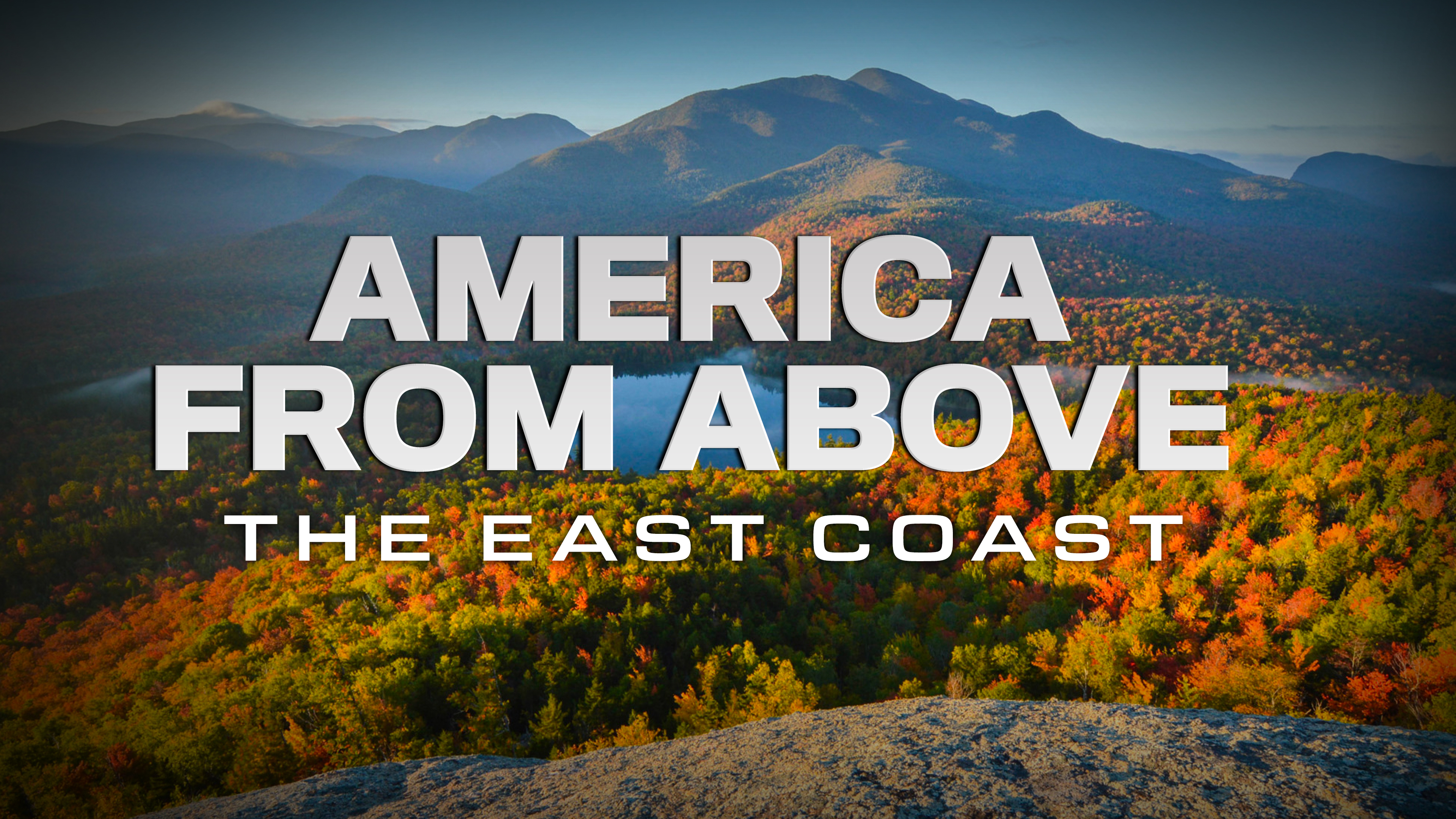 For a bird's eye view of the Hudson River Valley (and much more), watch Episode 11 of America from Above: The East Coast.
For a bird's eye view of the Hudson River Valley (and much more), watch Episode 11 of America from Above: The East Coast.
The Intermodal Surface Transportation Efficiency Act of 1991 led to increased funding for these projects, and the construction of rail trails has grown steadily since. According to the Rails-to-Trails Conservancy, the lead advocacy group for rail trails, roughly 23,500 miles of them exist in the U.S. They can be anything from a quiet gravel path in the woods to bustling commuter routes in cities.
Following the gentle grades needed for trains, rail trails provide ideal conditions for non-motorized transit. A key aspect is their lack of car traffic. Users will typically encounter cars only when crossing roads en route. Users flock to rail trails for more breathing room than they experience on roads, where vehicles are steadily getting bigger, often with large frontal blind spots.
While many construction projects can be time-consuming and costly, rail trails have the advantage of being jump-started by prior work. The right-of-way established by a railroad – the route defined on paper and cut through the landscape – was often done decades earlier. This gives planners more flexibility when installing a rail trail, since there’s less red tape to cut through.
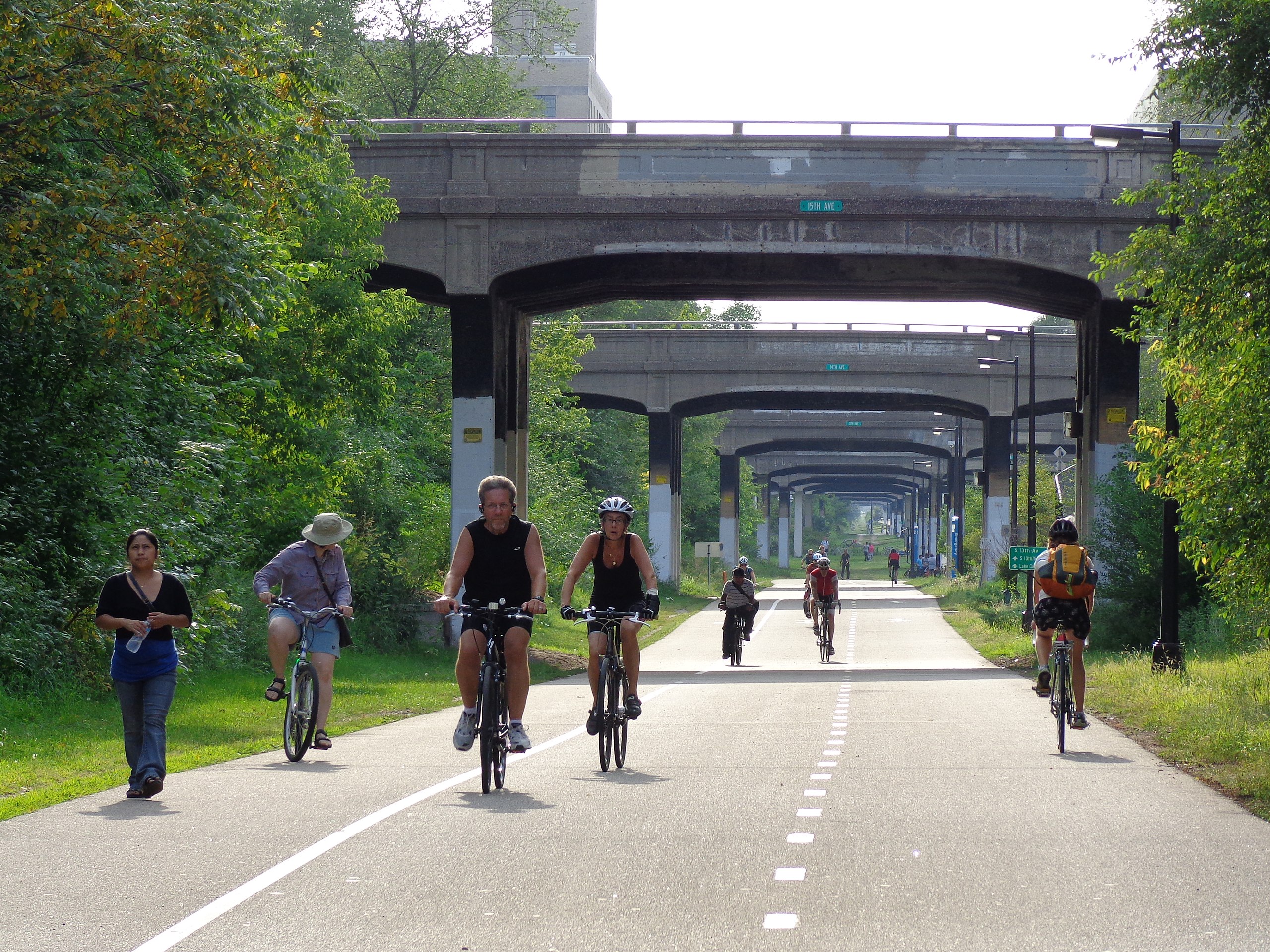 Midtown Greenway, Minneapolis, Minnesota (Source: Minneapolis Public Works TPP, via Wikimedia Commons)
Midtown Greenway, Minneapolis, Minnesota (Source: Minneapolis Public Works TPP, via Wikimedia Commons)
Economic Benefits of Rail Trails
Rail trails are a boon for local economies, drawing outdoorsy and fitness-minded tourists. It’s not unusual to see a pile of bikes stacked up outside a restaurant, with brightly-colored jerseys huddled around glasses of local beer. Rail trails bring together the young and old, runners and cyclists, Republicans and Democrats.
Homeowners along the routes can enjoy a boost to their property value of three to five percent, with some cases being as high as 15 percent. Part of that benefit is attributed to the relative quiet of rail trails. Active rail lines, by contrast, represent an auditory burden to those who live near them. This quieting of the landscape, and economic gain, are significant factors that can sway votes in planning meetings.
It seems like everyone loves rail trails. So, what’s the problem? Well, the problem is that we need trains, too.
 Metro-North Harrison Station, Harrison, New York (Source: Metropolitan Transit Authority of the State of New York, via Wikimedia Commons)
Metro-North Harrison Station, Harrison, New York (Source: Metropolitan Transit Authority of the State of New York, via Wikimedia Commons)
Passenger Rail in America
In rankings of passenger rail usage and infrastructure, the United States historically ranks lower than counterparts in Asia and Europe. In fact, according to 2019 statistics from the World Bank, the U.S. ranks 10th globally on rail passenger transport. The U.S. is home to successful rail networks in cities like New York and Chicago, but still lacks the widespread use seen in countries like China or France.
Many mass transit advocates view a greater use of passenger rail as the single most effective way to get automobiles off the road. A bi-level passenger train can hold over 100 people per car, with 10–15 cars per train. When factoring in the average automobile occupancy of 1.5 passengers, each train could potentially remove around 700 from the road. This would help to alleviate the pressures of traffic congestion and the pollution that comes along with it.
It’s More than Just the Trains on the Tracks
While rail trails can look like a zero-sum game between bikes and trains, the answers aren’t always so clear. The steps needed to increase train usage in the U.S. go beyond putting more trains on tracks.
For example, there are towns that might have looked like viable options for stations along the Dutchess Rail Trail, which stretches 13 miles east of the Walkway over the Hudson. But, upon a closer look, they reveal the same yawning sprawl that defines the American suburban landscape.
The rail trail hamlet of LaGrangeville, New York, population of about 8,000 residents, is similar in size to small villages dotting the U.K. countryside, such as Alnwick. While the U.K. model is often walkable hamlets around a central train station, American counterparts were commonly designed for the car. This car-centric design is often attributed to decades of auto industry lobbying and heavy-handed urban planners. If Americans are expected to drive to the train station, it diminishes the appeal of trains for short trips. On the other hand, in areas with higher population density and fewer cars, bicycles play an important role in transportation you can take with you on the train.
American towns can be tapped for passenger rail, but they can only be as successful as the urban planning around the station. The plans for a rail trail become infrastructure, the marching band attends a ribbon cutting, and local restaurants offer a themed burger. Residents buy bike carriers for their cars so they can drive to a place to ride their bikes.
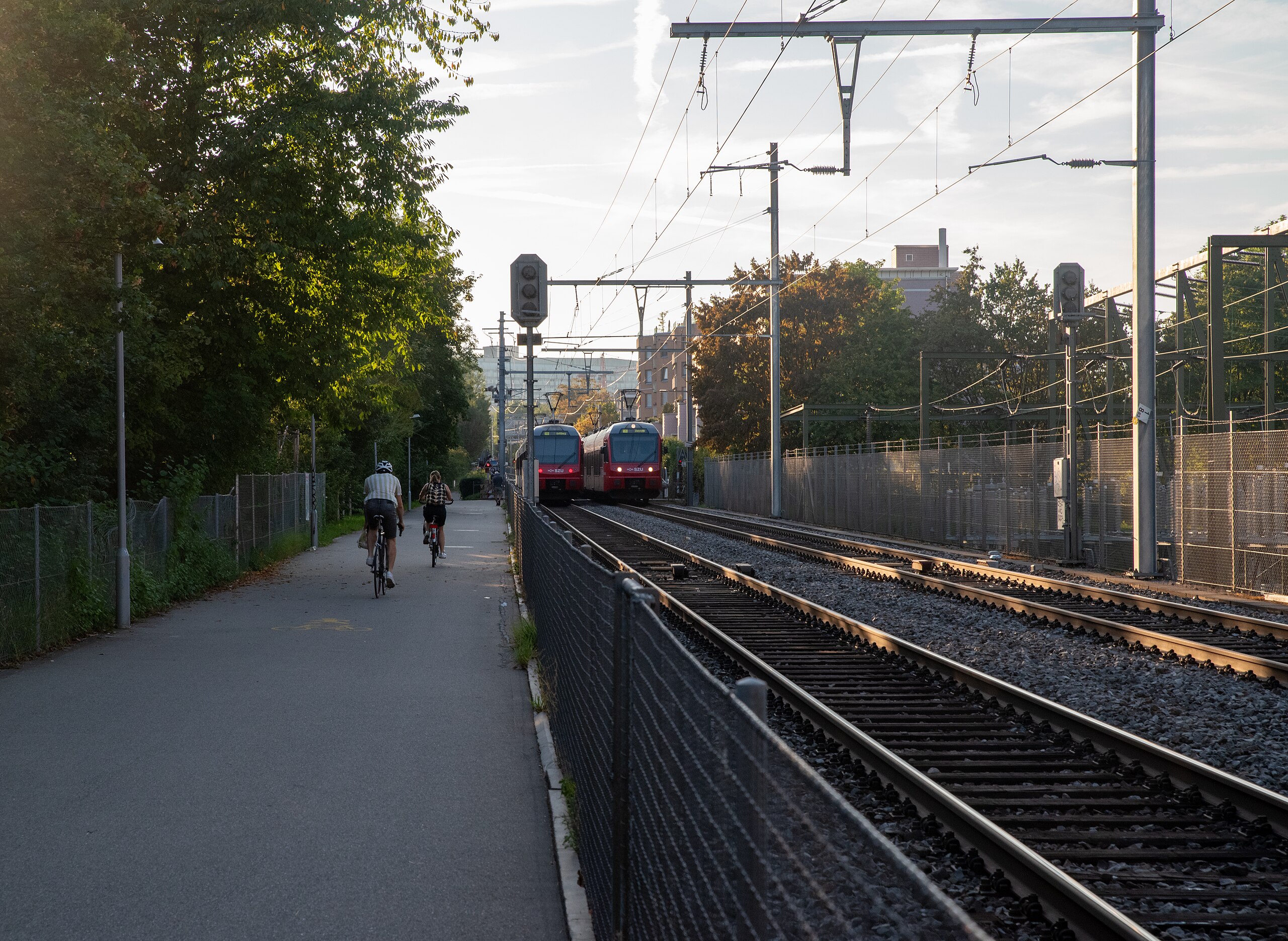 Rails with Trails, Zurich, Switzerland (Credit: Balise42, via Wikimedia Commons)
Rails with Trails, Zurich, Switzerland (Credit: Balise42, via Wikimedia Commons)
Can Hikers and Bikers Share the Trail with Railroads?
Despite the popularity of standalone rail trails, there are examples where rails and trails can coexist. The U.S. Department of Transportation (USDOT) refers to these paths as “Rails with Trails,” rail lines with bike paths beside them. According to a USDOT report, there are roughly 917 miles of rails with trails in the country, about four percent of the total rail trail network. They’re found beside freight and passenger rail alike.
These hybrid approaches do come with safety and experience-related concerns for both sides. Unsurprisingly, trail users typically prefer routes where there aren’t nearby cars or trains as distractions. And special arrangements typically need to be made by developers. The Rails-to-Trails Conservancy sets guidelines for things like treelines and for dividing the two pathways to make them more visually appealing and approachable. Rail companies must consider the liability of having pedestrians close to the track.
Making Peace with Change
When a rail trail replaces an abandoned railroad, it ends one era and ushers in the next. The dormant strip of land wakes up once more with joggers, strollers, and calls of “on your left.” The rail trail doesn’t kill the railroad; it can’t kill what’s already long gone. The rail trail takes the potential, the very idea that passenger rail could return for that route, and replaces it with something in the here and now.
Passenger rail adoption in the U.S. still lags behind other countries. It’s a lengthy, complicated process, going up against tight budgets and competing lobbyists. Colorado’s modest Front Range Rail project, putting passenger trains on existing freight lines, will cost an estimated $2 billion over 10-13 years of construction.
Outside the planning and zoning commissions, passenger rail still needs to be sold to a public that mostly thinks of driving first. Those challenges are a steep hill to climb, whereas a rail trail can bring benefits immediately at a lower price point. While the decision is nominally up to the public, budgets and time may have already done the choosing for us.
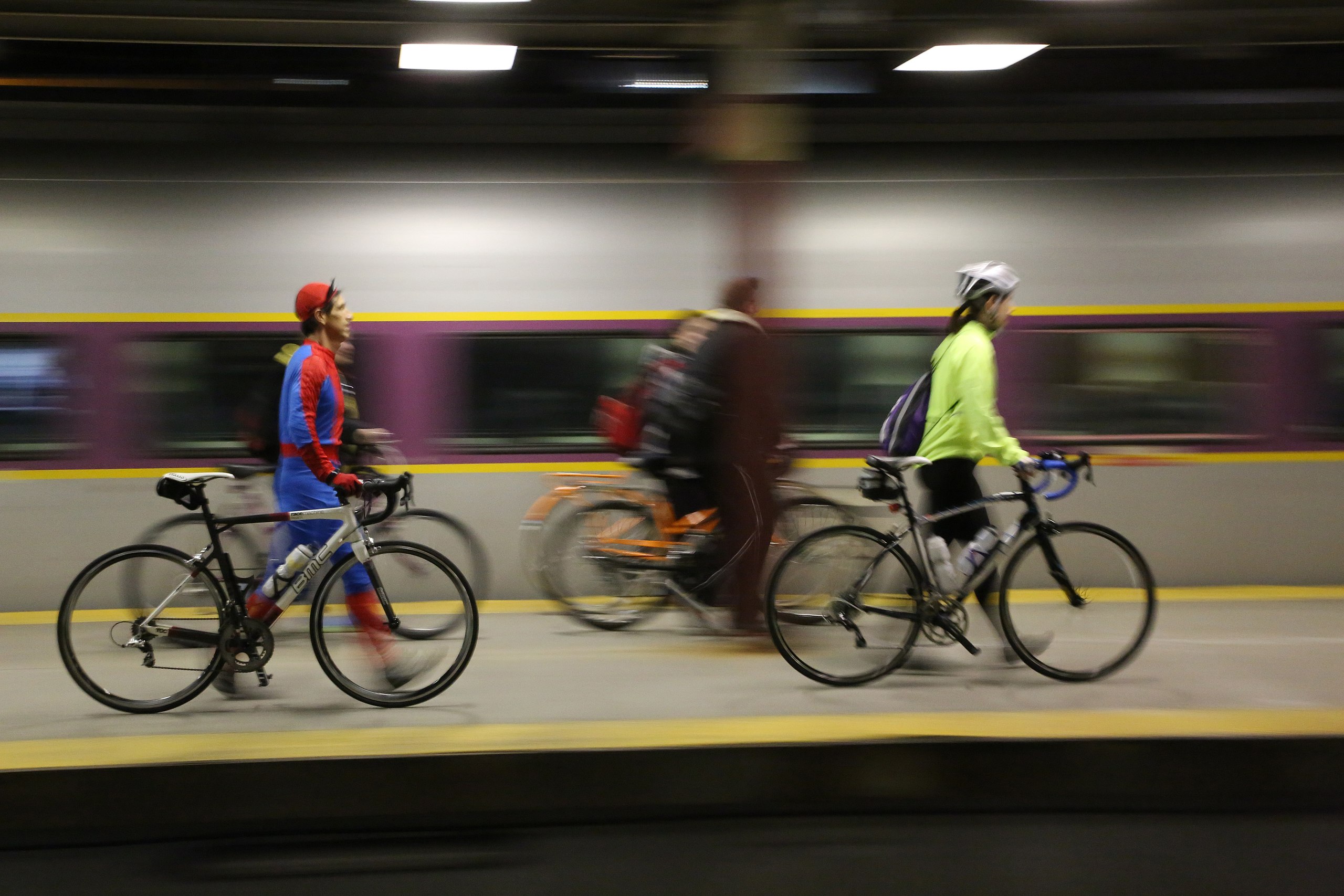 Cyclists at South Station, Boston, Massachusetts (Credit: Hannah Klarner, BU Interactive News, via Wikimedia Commons)
Cyclists at South Station, Boston, Massachusetts (Credit: Hannah Klarner, BU Interactive News, via Wikimedia Commons)
A Way Forward, Together
Could there be a future where a car-centric system doesn’t place trains and bikes on opposite sides? With the economic success of rail trails nationwide, the blueprint is already laid out. These projects work, and they enhance the communities they pass through. The benefits can be enough to justify building new trails, beyond the network of abandoned railroads.
Since bicycles are quieter and more maneuverable than trains, the rail trails’ infrastructure could be woven more cleanly into the transit system. A 10-foot path is easier to snake through town than the 30–50 foot corridor needed for a train. Building a bicycle path from scratch does present higher costs and legal challenges, compared to a rail trail. However, if the work is done properly, then it doesn’t close the door on passenger rail.
Rail trail users and train riders share a common motive: the desire to get away from cars. It falls on policymakers to think of how these two can fit better together, as part of a broader transit ecosystem. Infrastructure in other countries points to models in which both passenger rail and rail trails can live in harmony. When they’re supported together, they can succeed together.
Ω
Travis Norman is a writer and photographer, focusing on travel, cycling, and tabletop gaming. Originally from the Hudson Valley of New York, he now resides in the Upper Peninsula of Michigan. He can be found on Instagram at @travis_norman.
Title Image: Bizz Johnson Trail, Susanville, California (Source: California Bureau of Land Management, via Wikimedia Commons)
